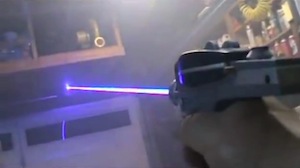Home
A comprehensive resource for safe and responsible laser use
UK: Reports of UFO over Coventry turns out to be light show laser
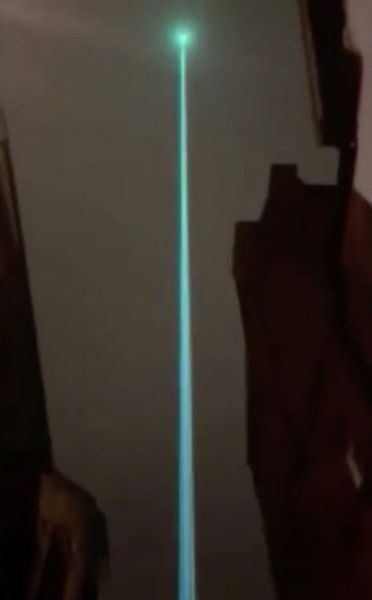
The blue-green shaft of light was from a laser said to be "the world's most powerful display laser." According to Mat Lawrence from the laser company Kvant, advance notice had been made to the U.K. Civil Aviation Authority before the test was done.
Lawrence said the beam could be seen from 20 miles away.

From The Star and Coventry Live
US: High-powered lasers can be obtained from inside a Christmas holiday laser projector
In a January 22 2018 Hackaday post, Tom Nardi purchased a “Home Accents Holiday Multi-Color Light Projector” from a hardware chain on clearance, marked down from $56 to just $14.
He removed the cover with four screws and found the parts inside used connectors instead of solder: “It’s like they wanted us to strip it for parts.”
The lasers were defocused inside. “…[A]t 3 meters the spots looked as large as dinner plates…. Once focused, it becomes pretty clear that these lasers are quite a bit more powerful than the <5 mW listed on the product’s warning sticker.”
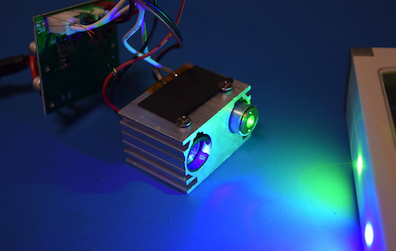
The green and blue laser diode modules inside the holiday projector
Nardi noted that the blue laser, when focused, was “easily able to burn pieces of paper and punch holes in black plastic.” He also estimated that the green laser was “at least twice as bright” as a laser pointer he owns that claims to be 50 mW: “…it certainly would not surprise me if they are both [green and blue] at least 100 mW.”
Nardi writes: “If your biggest take-away from this post is that the Home Depot is selling a 440 nm laser you can use to burn stuff, I certainly don’t blame you.”
From Hackaday. LaserPointerSafety.com has a page with more information, including measurements of the beam output of a Star Shower projector, here.
Commentary from LaserPointerSafety.com: In fairness to Home Accents, the FDA-required warning sticker has to do with the laser power of the unopened unit in its factory configuration. Class 3R (IIIa) laser projectors like this are not allowed in the U.S. to be over 5 mW output power. It may be that after going through the holographic diffraction grating that creates the stars, that the Home Accents projector meets Food and Drug Administration requirements for user access to laser light.
UK: UPDATED - Medical report on commercial pilot injured by blue laser at 1300 feet
“An airline pilot presented to our department complaining of a blind spot in the upper left area of his visual field in the right eye (right supero-nasal scotoma) following exposure to a laser beam while performing a landing maneuver of a commercial aircraft. At around 1300 ft (396 m), a blue laser beam from the ground directly entered his right eye, with immediate flash blindness and pain. Spectral domain ocular coherence tomography highlighted a localized area of photoreceptor disruption corresponding to a well demarcated area of hypofluorescence on fundus autofluorescence, representing a focal outer retinal laser injury. Fundus examination a fortnight later revealed a clinically identifiable lesion in the pilot’s right eye commensurate with a retinal-laser burn.”
The paper said the pilot’s symptoms “fully resolved 2 wk later” and that there was no “deficit in visual function.”
Click to read more...
Saudi Arabia: Handheld blue-light lasers can cause macular hole in retina
The study, reported in the July 2015 American Journal of Ophthalmology, looked at 17 eyes of 17 patients at two institutions, between January 2012 and May 2014. Most were youths (mean patient age 18 years; range: 11 to 30 years old). The eyes were exposed to blue laser light for less than one second, at a mean distance estimated to be about 1 meter from the laser. The time from exposure to the patient visiting the hospital for treatment ranged from two days, to almost 500 days.
Patients were given a full ophthalmic examination, including fundus photography, macular spectral-domain optical coherence tomography, and fundus fluorescein angiography.
The macular holes ranged from 0.17 millimeters to 0.62 mm, with a mean diameter of 0.35 mm.
In 14 of the eyes, surgeons went deep into the eye and removed vitreous gel (a pars plana vitrectomy); this removes clouded gel that may contain blood from the injury. At the same time surgeons also did a procedure called “internal limiting membrane peeling,” which uses an instrument to make a break in the membrane which is then peeled away with forceps.
In 11 of the 14 eyes, the operation completely closed the macular hole. Of the other three unoperated eyes, the eye with the smallest macular hole spontaneously closed.
Before the operation, the mean Snellen best corrected visual acuity (BCVA) was 20/210, or about 1/10th the normal visual acuity; the range was from 20/30 to 2/200. After the operations, the mean BCVA was 20/62 (range: 20/20 to 4/200). These statistics included all eyes (the 14 operated eyes and the three unoperated ones).
The authors concluded “Full-thickness MH can result from momentary exposure to high-power handheld laser devices. While spontaneous closure may occur in rare cases, most cases require early surgical intervention. Vitrectomy may be successful in closing the macular hole with visual acuity improvement in most of the cases.”
From the abstract of the study by Alsulaiman SM, et al., “Full-Thickness Macular Hole Secondary to High-Power Handheld Blue Laser: Natural History and Management Outcomes” in the American Journal of Ophthalmology, July 2015 Vol. 160, Issue 1, Pages 107-113.e1.
Note: Other studies have been published based on this data, an August 2013 LaserPointerSafety.com story about the first study is here.
US: Review of 1-watt blue laser with US-required safety features
The SKY Technologies Blue Handheld includes a keyswitch, 3-5 second emission delay, remote interlock, and a shutter to cut off the beam, as required by FDA regulations enforced by the agency’s Center for Devices and Radiological Health (CDRH). Under current (May 2014) law, the laser appears to be legal for sale and use in the U.S., assuming the manufacturer also submitted a proper Laser Product Report and has filled all other FDA/CDRH import and paperwork obligations.*
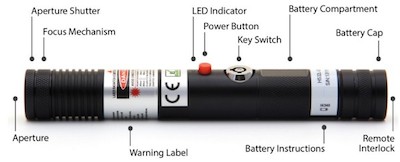
Germany: Latest film-inspired laser shoots beams out of glasses
The technique is to look in the desired direction with the red aiming beams on, then to switch on the blue beams while looking at the desired target. The glasses have a lens that attenuates blue laser light, so that the user is protected in case of any reflected blue beams.
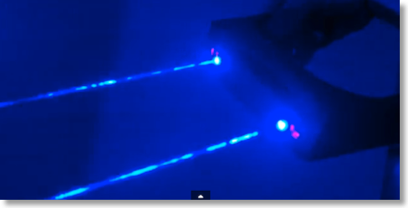
The two blue beams emitted from Priebe’s glasses, each roughly 1 watt, can burn cloth and pop balloons.
His inspiration: Cyclops’s 2-gigawatt “optic blast,” which is red in the Marvel comic books.
An online YouTube video shows Priebe’s laser glasses in action:
Due to the inherent danger of head-worn lasers, Priebe is not making additional glasses and he is not offering plans for others to build their own.
Priebe has previously built custom laser gadgets such as a replica of Iron Man’s palm-mounted repulsor ray projector, a laser “Gatling gun” with six rotating 1.4 watt blue beams, and a laser gun that emits a non-visible 1 megawatt pulse.
From Gizmodo. Original video posted by AnselmoFanZero.
Saudi Arabia: UPDATED - 14 young patients injured by high-powered handheld lasers
According to HealthNewsDigest.com, “All injuries occurred during play and involved teenage boys and young males, between the ages of 11 and 30. Some injuries were accidental, but others involved a playmate intentionally pointing the laser beam at the victim's eye. The distance between the victim's eye and the laser beam ranged from 1.7 feet to 20 feet (a half-meter to 6 meters). Those who suffered retinal holes were injured at the closest distance, around half meter, or 1.7 feet. Generally, injury from greater distance resulted in less serious damage, the authors of the report say.”
The report was presented August 24 2013 during a Toronto meeting of the American Society of Retina Specialists by Fernando Arevalo, M.D. He is professor of ophthalmology at the Wilmer Eye Institute, Johns Hopkins School of Medicine, in Baltimore Maryland and is also affiliated with the Saudi hospital. Dr. Arevalo hopes that his findings, which were provided to the Minister of Health, will result in changes to how Saudi Arabia regulates handheld lasers.
Click to read more...
Germany: Hobbyist creates laser "Gatling gun" with six rotating 1.4 W blue beams
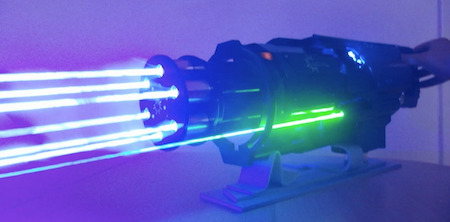
US: UPDATED - Video of homemade 3 watt handheld laser gains attention
Lasers in the 1 watt range have been widely available since the mid-2010 introduction of the Wicked Laser Spyder III Arctic blue laser. This is the first handheld 3 watt laser that LaserPointerSafety.com has been aware of.
Click to read more...
US: Man builds a replica Star Trek phaser
This is not the first time such a project has been done. In 2007, Kip Kedersha (“Kipkay”) posted a YouTube video showing how he bought a surplus Playstation 3 laser diode for $45 and a Star Trek toy for $30, in order to make a laser-emitting phaser.
A Huffington Post story has the 2012 video, as well as links to earlier videos and detailed build instructions.
From Reddit via the Huffington Post
US: Amateur astronomers illuminate International Space Station with spotlights and 1-watt laser
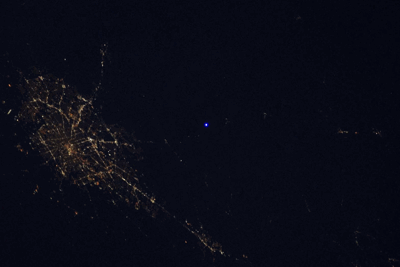
Two-frame animated GIF showing bright and dim light from the Lozano Observatory (center) near the city of San Antonio (left). North is to the right in this photo from the International Space Station, taken by astronaut Don Pettit. Click on photo for a larger version.
The spotlights were flashed at the ISS by holding plywood sheets in front of the lights every two seconds. This procedure can be seen in the video below.
The animated GIF above shows a bright blue light alternating with a dim light. The bright light is almost certainly from the spotlights. The bluish tint may be an artifact of oversaturating the camera’s sensor. Astronaut Don Pettit reported that the bright light appeared white, and the dim light appeared blue. He wrote “We could only see the laser when the white light was off and not all the time.” (E.g., the white spotlights overpowered the blue laser.) He added, “It was like there were tracking issues with the laser to keep it on target.”
The dim light in the animated GIF may be the laser only, or it may be light from the spotlights that wasn’t fully blocked by the plywood sheets. The astronomers will be working with Pettit, trying to pin down exactly how visible the laser light was.
